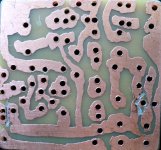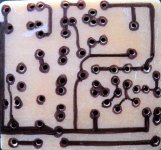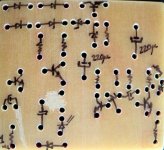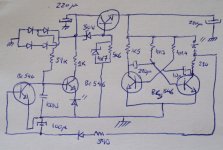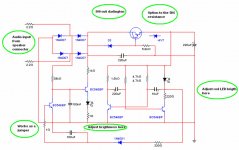I had not the intention to publish because it is too much simple, a toy and has their problems, the limits.... customized to the Dx Blame MKII Supercharged amplifier, can burn if installed into other amplifiers that can put out much more than 35 volts RMS.
This indicator shows 10 watts in a green led that modulates depending the audio, when the power reaches almost 100 watts (not precise) the multivibrator starts to work and RED led flashing frequency depends on the multivibrator frequency...so...less modulated by audio frequency and much more indicating it's own timing.
When Red led goes one it forces the green led to go off...this is interesting not to have several LEDs flashing in the panel...the one will be appearing from time to time (normal listening level is less than 10 watts average) will be the green led...the RED led will show you that you have reached the specified limit of power...in the reality, the Dx Blame MKII Supercharged can put out more than 150 watts (8 ohms)...but around 110 watts when distortion is 0.002% THD..... pushing it to the limit distortion will increase, naturally.
The first issue is that you cannot use higher power... or force the red LED to be on full brigth as this will burn part of the circuit.... to protect against abuse will be expensive... the optional zener may help but cannot hold too much power even if you use 5 watts zener...so.... the toy circuit must be used with some care...i have tested for several days and worked fine... reason why i am sharing with you.
The second issue is that it is not precise and you may need to adjust LED series resistances to match LED brightness.
Third issue is that will need adjustment to operate in other amplifiers having other power ratios....this one was made to the Dx Blame MKII Supercharged...a 100/200 watts RMS power amplifier.
There's 4 videos in sequence that will be posted that will explain more details...here you have the first one:
YouTube - LED meter, Volts meter, light indicator gadget - 1
It is nice and interesting..but a real gadget... a toy that may be interesting for some of you...also a real DIY style thing... to produce at your home...and with your own hands... as a craftsman.
Some pictures will help you to understand the circuit..very simple for sure.
regards,
Carlos
This indicator shows 10 watts in a green led that modulates depending the audio, when the power reaches almost 100 watts (not precise) the multivibrator starts to work and RED led flashing frequency depends on the multivibrator frequency...so...less modulated by audio frequency and much more indicating it's own timing.
When Red led goes one it forces the green led to go off...this is interesting not to have several LEDs flashing in the panel...the one will be appearing from time to time (normal listening level is less than 10 watts average) will be the green led...the RED led will show you that you have reached the specified limit of power...in the reality, the Dx Blame MKII Supercharged can put out more than 150 watts (8 ohms)...but around 110 watts when distortion is 0.002% THD..... pushing it to the limit distortion will increase, naturally.
The first issue is that you cannot use higher power... or force the red LED to be on full brigth as this will burn part of the circuit.... to protect against abuse will be expensive... the optional zener may help but cannot hold too much power even if you use 5 watts zener...so.... the toy circuit must be used with some care...i have tested for several days and worked fine... reason why i am sharing with you.
The second issue is that it is not precise and you may need to adjust LED series resistances to match LED brightness.
Third issue is that will need adjustment to operate in other amplifiers having other power ratios....this one was made to the Dx Blame MKII Supercharged...a 100/200 watts RMS power amplifier.
There's 4 videos in sequence that will be posted that will explain more details...here you have the first one:
YouTube - LED meter, Volts meter, light indicator gadget - 1
It is nice and interesting..but a real gadget... a toy that may be interesting for some of you...also a real DIY style thing... to produce at your home...and with your own hands... as a craftsman.
Some pictures will help you to understand the circuit..very simple for sure.
regards,
Carlos
Attachments
You may be interested in calculations or formulas...i am sorry, this was made
in a very diy amateur way.... a try and error basis.... i have used a simulator to help me and the voltage threshold are referenced by zener diodes.... was build and adjusted real world and simulator values have not worked...i had to change a lot of things to match reality.
Needing calculations you may ask these guys that are good on that, alike Andrew T and others that should help you to adapt to your needs.
I am satisfied with this toy and gonna use it the way it is...but of course feel free to suggest modifications to make it better and publish as some folks may be interested to see your ideas.... despite i do think it will be a better idea to open a new thread to a new meter..this way people will have more options and more threads... also less confusion.
Here you have some more images attached,
regards,
Carlos
in a very diy amateur way.... a try and error basis.... i have used a simulator to help me and the voltage threshold are referenced by zener diodes.... was build and adjusted real world and simulator values have not worked...i had to change a lot of things to match reality.
Needing calculations you may ask these guys that are good on that, alike Andrew T and others that should help you to adapt to your needs.
I am satisfied with this toy and gonna use it the way it is...but of course feel free to suggest modifications to make it better and publish as some folks may be interested to see your ideas.... despite i do think it will be a better idea to open a new thread to a new meter..this way people will have more options and more threads... also less confusion.
Here you have some more images attached,
regards,
Carlos
Attachments
I am still uploading to youtube.... there are 4 parts
all them small... less than 5 minutes average...i have to do that as my Hard Drive is full.
Here you have second part:
YouTube - LED meter, power meter, light indicator gadget - 2
regards,
Carlos
all them small... less than 5 minutes average...i have to do that as my Hard Drive is full.
Here you have second part:
YouTube - LED meter, power meter, light indicator gadget - 2
regards,
Carlos
Here you have the third part
YouTube - LED meter, power meter, light indicator gadget - 3
The last video:
http://www.youtube.com/watch?v=ja4ObOwCbHs
regards,
Carlos
YouTube - LED meter, power meter, light indicator gadget - 3
The last video:
http://www.youtube.com/watch?v=ja4ObOwCbHs
regards,
Carlos
Last edited:
I am so excited with this circuit that i would like to make a phone call to each one
of you to explain this circuit...as people seems not to mind about...maybe because i have named as gadget..... prejudices was invited to take place in that moment.
Well, this circuit is a hell interesting and super clever...the idea appeared down the seventies (not the circuit) and i found it awsome...because does not use supply....and not using supply you can install these things inside a speaker...then, if you have a low power speaker that you like, alike i have my bookshelves, and you feel afraid to blow your speaker because excesses of power...then you have signal flashing to you, indicating the dangerous levels you can adjust according to your needs.
I use to listen Pipe Organ...i love Mormon pipe Organ playing.....i am not deeply religious, just Christian...but i do love pipe organ playing..and these things have very low frequencies you cannot listen while using bookshelf speakers..but your drivers may smell till the death..they may melt and burn easy..as huge power in low bass is going, you do not notice and you continue to increase your volume to listen the choir.
I will insist recalling this thread, as i do think this is a very nice TOOL for us to use, not only inside power amplifiers but also, and much better, as power (or voltage..and this is the same..as voltage together current means power) can be monitored while you listen your lovely bookshelf speakers...lamps will flash and will inform you huge off set, also excesses of power to your beloved speakers...... and as you know..the best speakers are not high power ones..observe what genius Nelson Pass uses....his speakers are not high power..not only because his amplifiers are not high power but also because the very good ones are not high power...they are soft to move, very efficient and use to produce loud tones with 1 watt of audio entering...these ones are the ones this circuit and produce light signals to inform you that you may blow your speakers.
Picture is my need to call you by phone asking for your attention (my young daugther)....this circuit is very, very, very usefull and interesting.
regards,
Carlos
of you to explain this circuit...as people seems not to mind about...maybe because i have named as gadget..... prejudices was invited to take place in that moment.
Well, this circuit is a hell interesting and super clever...the idea appeared down the seventies (not the circuit) and i found it awsome...because does not use supply....and not using supply you can install these things inside a speaker...then, if you have a low power speaker that you like, alike i have my bookshelves, and you feel afraid to blow your speaker because excesses of power...then you have signal flashing to you, indicating the dangerous levels you can adjust according to your needs.
I use to listen Pipe Organ...i love Mormon pipe Organ playing.....i am not deeply religious, just Christian...but i do love pipe organ playing..and these things have very low frequencies you cannot listen while using bookshelf speakers..but your drivers may smell till the death..they may melt and burn easy..as huge power in low bass is going, you do not notice and you continue to increase your volume to listen the choir.
I will insist recalling this thread, as i do think this is a very nice TOOL for us to use, not only inside power amplifiers but also, and much better, as power (or voltage..and this is the same..as voltage together current means power) can be monitored while you listen your lovely bookshelf speakers...lamps will flash and will inform you huge off set, also excesses of power to your beloved speakers...... and as you know..the best speakers are not high power ones..observe what genius Nelson Pass uses....his speakers are not high power..not only because his amplifiers are not high power but also because the very good ones are not high power...they are soft to move, very efficient and use to produce loud tones with 1 watt of audio entering...these ones are the ones this circuit and produce light signals to inform you that you may blow your speakers.
Picture is my need to call you by phone asking for your attention (my young daugther)....this circuit is very, very, very usefull and interesting.
regards,
Carlos
Attachments
Here you have the DIY board assembled and operating
YouTube - LED power indicator to use inside speaker enclosure or power amp
regards,
Carlos
YouTube - LED power indicator to use inside speaker enclosure or power amp
regards,
Carlos
- Status
- This old topic is closed. If you want to reopen this topic, contact a moderator using the "Report Post" button.
